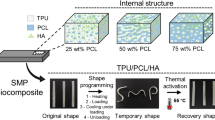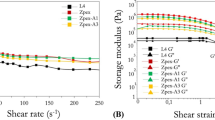Abstract
Bone cements are mainly based on acrylie polymers, poly (methyl methacrylate) (PMMA) being the most representative. The curing process (cold curing) is the result of the free radical polymerization of a mixture of beads of PMMA and methyl methacrylate (MMA), initiated by benzoyl peroxide (BPO) and activated by the presence of a tertiary amine, the most classical being N,N-dimethyl-4-toluidine (DMT). In this work the results on the effect of the size and size distribution of PMMA beads and the concentration of DMT and BPO on the setting parameters, the residual monomer content and the mechanical properties (tension and compression) of the cured systems are presented. The use of relatively larger diameter PMMA beads improves the characteristic parameters of the curing process (decreasing the peak temperature and increasing the setting time), without detrimental effects on the mechanical properties of the cured cement.
Similar content being viewed by others
References
J. CHARNLEY, J. Bone Jt Surg. 42B (1964) 28.
J. CHARNLEY, J. Bone Jt Surg. 46B (1964) 518.
J. CHARNLEY, “Acrylic cement in orthopaedic surgery” (E&S Livingstone, London, 1970).
R. C. TURNER, P. E. ATKINS, M. A. ACKLEY and J. B. PARK, J. Biomed. Mater. Res. 15 (1981) 425.
G. M. BRAUER, D. J. TERMINI and G. DICKSON J. Biomed. Mater. Res. 11 (1977) 577.
S. C. BAYNE, E. P. LAUTENSCHLAGER, C. L. COMPERE and R. WILDES. J. Biomed. Mater. Res. 9 (1975) 27.
J. B. PARK and R. S. LAKES, “Biomaterials. An introduction”, 2nd Edn (Plenum Press, New York, 1992) p. 154.
B. D. RATNER, in “Comprehensive polymer science”, Vol. 7 (Pergamon Press, Oxford, 1989) p. 201.
B. PASCUAL, I. CASTELLANO, B. VAZQUEZ, I. GOÑI, M. GURRUCHAGA, M. P. GINEBRA, F. J. GIL, J. A. PLANELL, B. LEVENFELD and J. San ROMÁN. Biomaterials 17 (1996) 509.
S. S. HAAS, G. M. BRAUER and G. DICKSON, J. Bone Jt Surg. 57A (1975) 380.
S. C. BAYNE, E. P. LAUTENSCHLAGER, E. H. GREENER and E. P. MEYER, J. Biomed. Mater. Res. 11 (1977) 859.
E. P. LAUTENSCHLAGER, S. I. STUPP and J. C. KELLER, in “Functional behaviour of orthopaedic biomaterials”, Vol. II: Applications, edited by P. DUCHEYNE and G. W. HASTINGS (CRC Press, Boca Raton, FL, 1984) p. 97.
E. P. LAUTENSCHLAGER, S. I. STUPP and J. C. KELLER, in “Functional behaviour of orthopaedic biomaterials”, Vol. II: Applications, edited by P. DUCHEYNE and G. W. HASTINGS (CRC Press, Boca Raton, FL, 1984) p. 97.
Author information
Authors and Affiliations
Additional information
This paper was accepted for publication after the 1995 Conference of the European Society of Biomaterials, Oporio, Portugal, 10–13 September.
Rights and permissions
About this article
Cite this article
Ginebra, M.B., Gil, F.X., Planell, J.A. et al. Relationship between the morphology of PMMA particles and properties of acrylic bone cements. J Mater Sci: Mater Med 7, 375–379 (1996). https://doi.org/10.1007/BF00154553
Issue Date:
DOI: https://doi.org/10.1007/BF00154553




